Easy Twisted Chocolate Croissant French Bread
This easy twisted chocolate croissant french bread is the best way to get a buttery, flaky chocolate croissant…but with half the work!
After the crazy popularity and success of the original twisted croissant French bread, it was just a matter of time until a chocolate version made an appearance.
In this chocolate croissant French bread, dark chocolate is enrobed in flaky, buttery layers of soft French bread, and it is easily one of the best things I’ve ever made (or eaten!).
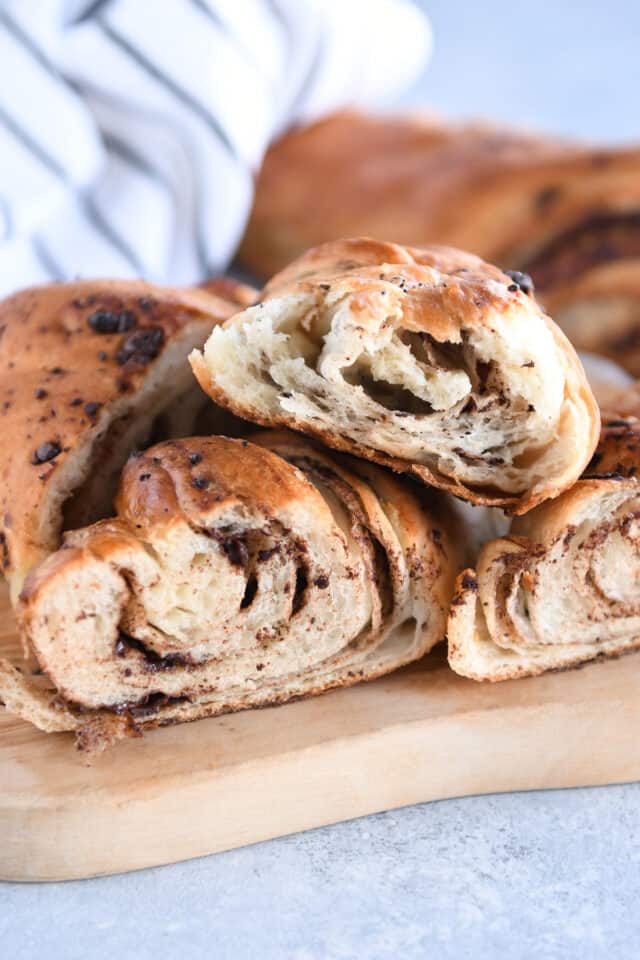
French Bread Dough
Just like the original twisted croissant recipe, the dough is simple, foolproof, and so easy to work with – it is perfect for this croissant bread!
Using any stand mixer of your choice (or making it by hand with a bowl and spoon), mix and knead the dough ingredients until a soft, smooth dough forms. Let it rise until doubled.
In order to ensure the dough is easy to roll out, don’t over flour the dough! Add flour until the dough is soft and slightly sticky but easily clears the sides of the bowl. It should leave a light residue on your fingers but not be overly wet and sticky.
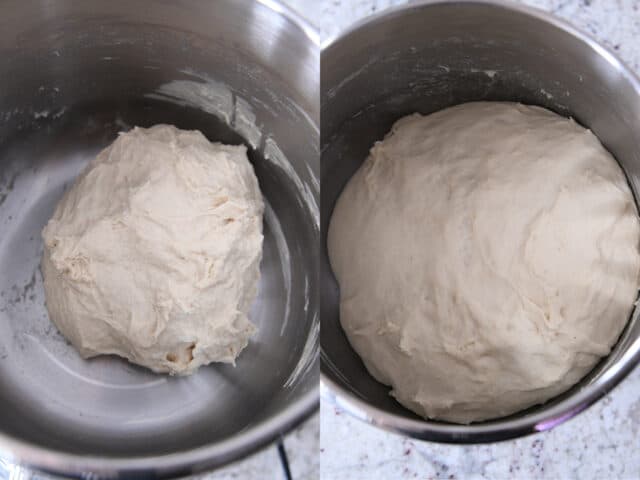
How to Make a Butter Sheet
The butter sheet is instrumental in creating the flaky layers in the chocolate croissant French bread.
To make the butter packet and butter sheet:
- Grab a piece of parchment paper about 16 1/4-inches by 12-inches (doesn’t have to be exact, but should be close to those dimensions). The precut sheets are about this size.
- Fold the two short edges on each side in toward each other about 4 1/2 inches. They will overlap a bit. Crease the edges well.
- Keep those edges folded in and fold the top and bottom edges over about 1 3/4-inches.
- When all the edges are folded in, it will form a little parchment packet with the center rectangle dimensions about 8 1/2-inches by 7-inches.
Don’t stress too much about the folding – these are just guidelines. If the folds are off by a little bit, it’s not going to be a problem as long as the folds completely enclose the center area where the butter will go. For exact measurements, check out the reference chart on this post.
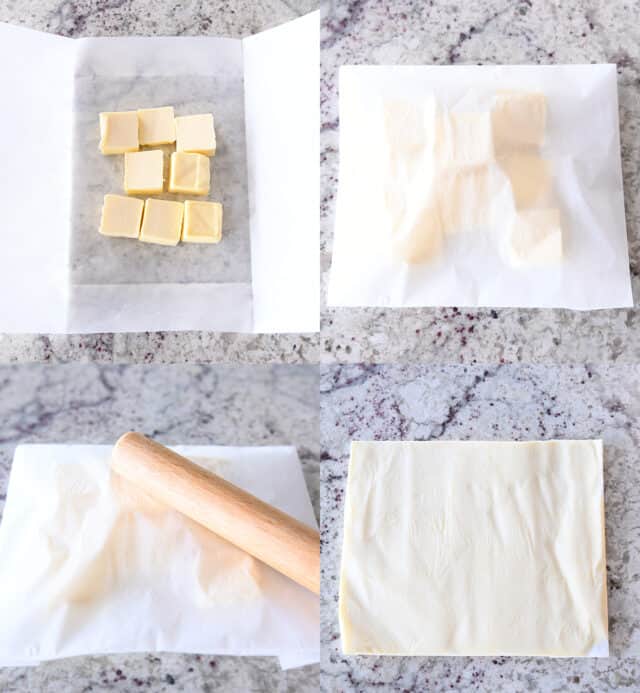
How to Fold and Roll Out the Chocolate Croissant Bread
When the dough has risen and butter has chilled, lightly punch down the dough and turn out onto a lightly floured counter.
Roll the dough into a rectangle about 18-inches by 11- or 12-inches.
Take the butter packet out of the refrigerator, and unfold the parchment (but leave the butter on the parchment paper). Place the butter packet face down on the center of the rolled out bread dough. Peel the parchment carefully off the butter leaving the butter sheet on the dough.
Using the pictures below as a reference, begin by folding one short side of dough about halfway to 2/3 over the butter. Fold the other short side of dough over the butter, overlapping the first folded side by about an inch.
Fold the top and bottom edges over about 1/2- to 1-inch and press to seal and then fold the dough in half lengthwise to form a rectangle loaf.
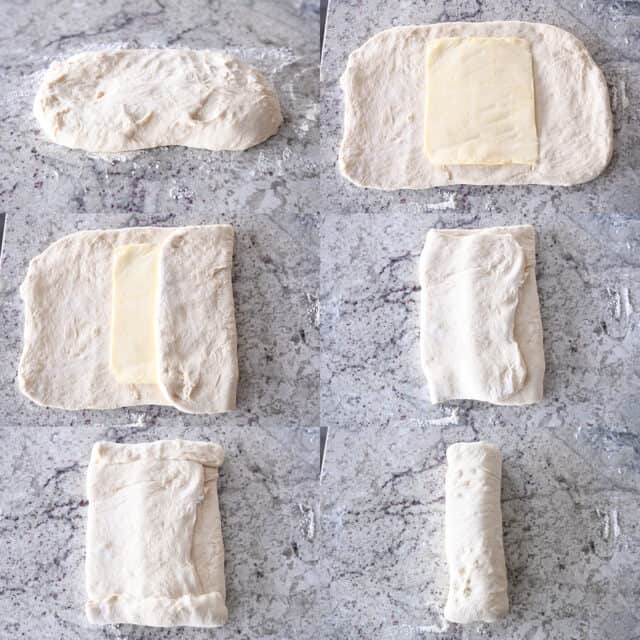
Rolling and Folding
Roll the thick, folded loaf into a long rectangle about 8-inches by 22-inches. If the dough springs back when rolling, let it rest for 5-10 minutes to let the gluten relax and roll again.
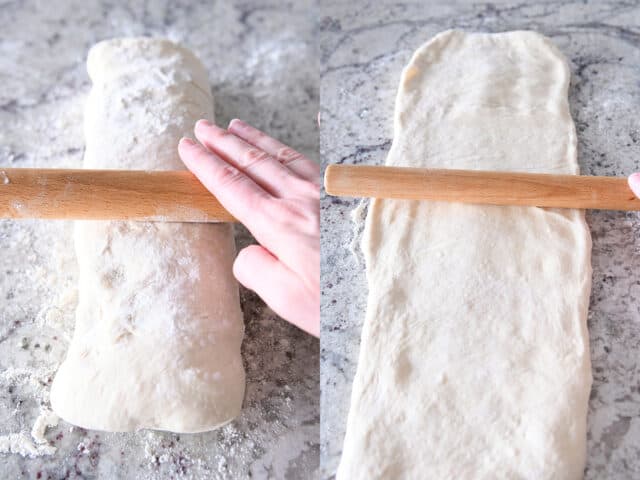
What Kind of Chocolate to Use
Coarsely chop about one cup of good quality semisweet or dark chocolate. A good/high quality chocolate is important here for taste and also for texture/meltability.
I use Ghirardelli bittersweet chocolate chips and coarsely chop them or run them through a few pulses in a food processor. They melt better than any other brand of chocolate chips. A high quality bar of chocolate will work well, too.
I would NOT recommend other brands of chocolate chips (I tried this bread with Costco-brand semisweet chocolate chips and it wasn’t great).
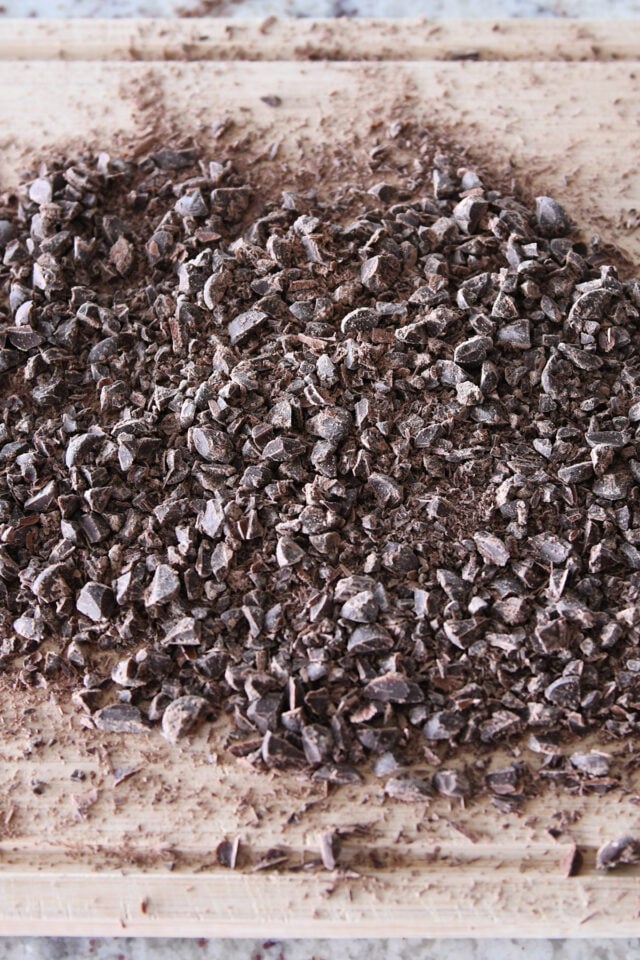
How to Incorporate Chocolate Into the Dough
Sprinkle about 2/3 of the chocolate across the rolled out dough and press the chocolate lightly into the dough.
Fold up the bottom half of the dough followed by the top half of the dough to meet in the middle. The chocolate will get disrupted and fall out of place a bit – that’s ok.
Sprinkle the rest of the chocolate on the bottom half of the dough and press it lightly into the dough. Fold the dough in half so the top half of the dough folds over the bottom half.
*If this folding process is confusing, check out the Instagram reel here that shows the whole process.*
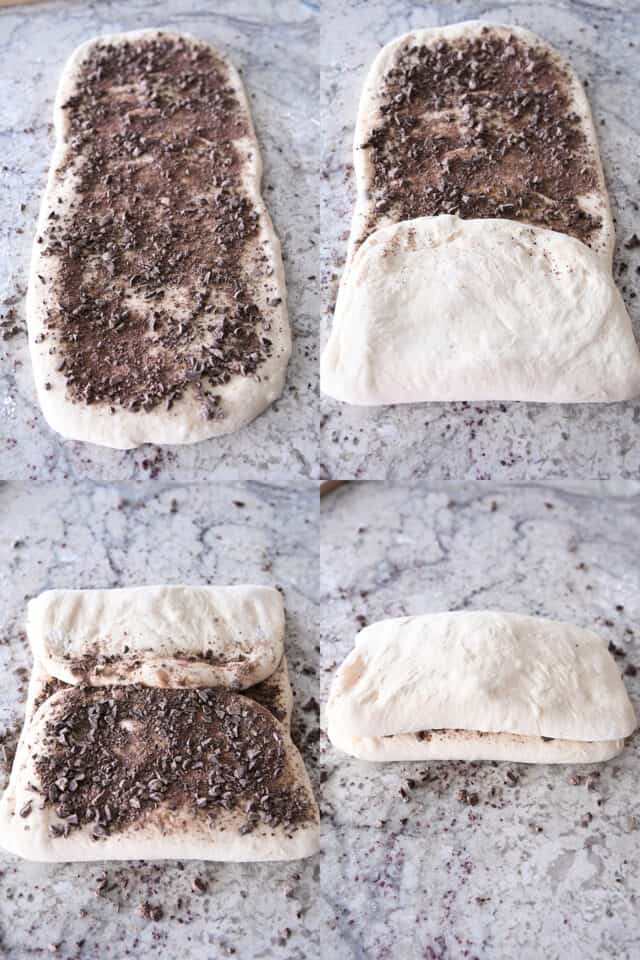
Roll the folded dough into a 12-inch or 13-inch square. You might see little bubbles on the surface of the dough. Totally normal (don’t deliberately pop them!).
And edges of chocolate might pop through the surface of the dough. That’s ok, too!
Cut the square into four strips.
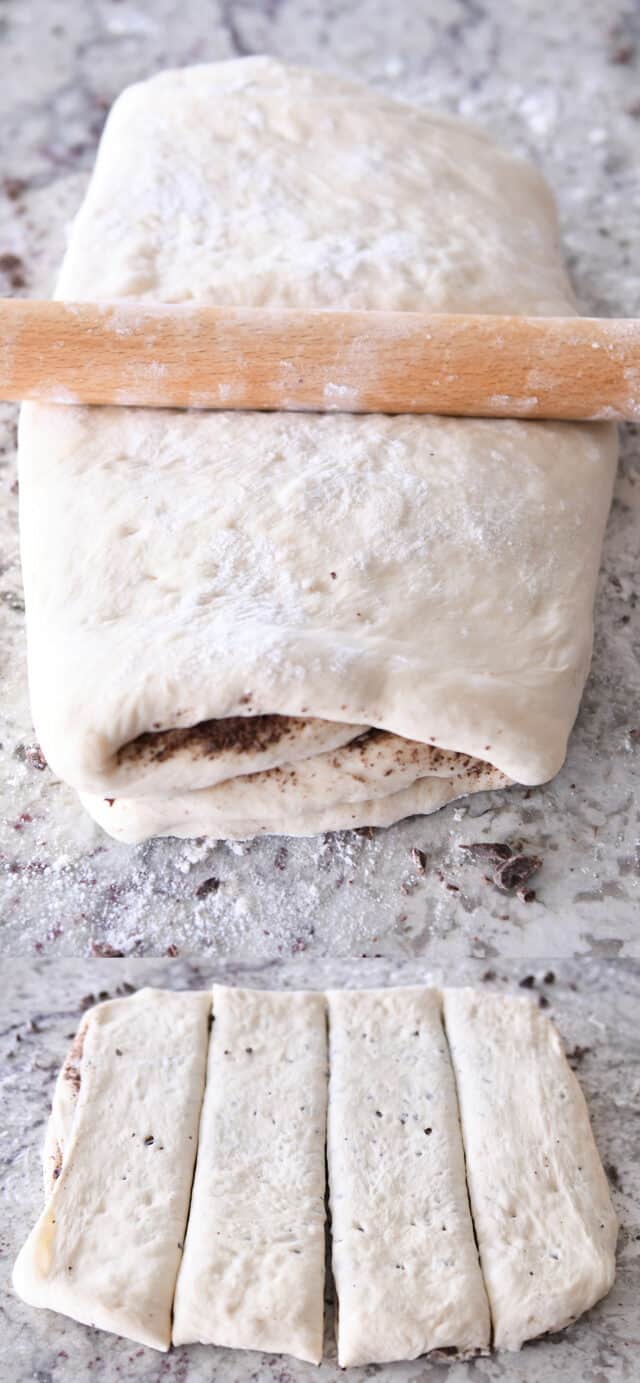
Twist each strip and place on parchment-lined half sheet pans.
When you lift the twisted strips up to put on the prepared pans, do so carefully so the loaves don’t get stretched out.

Rise and Bake
Let the loaves rise until noticeably puffy in a relatively cool spot so the butter inside the dough doesn’t melt.
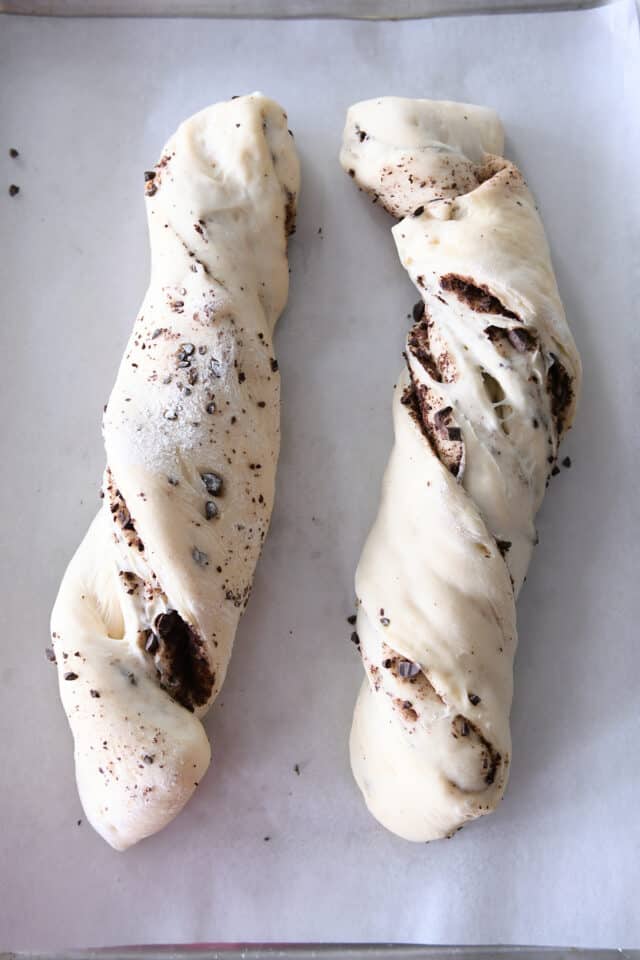
Bake until golden, about 20-22 minutes in a 375 degree F oven (bake at 400 degrees F for a darker crust).
Immediately out of the oven, use a pastry brush to brush any of the butter on the sheet pan onto the top and sides of the loaves.
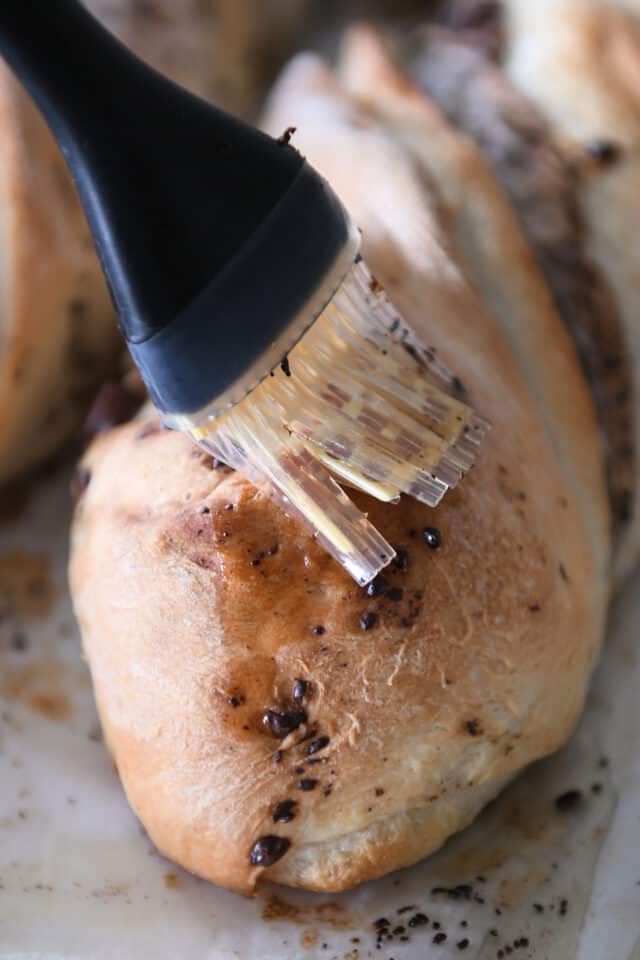
Every Loaf is Unique
This bread is curvy and beautiful in a one-of-a-kind way, and no two loaves will look the same thanks to the rolling and folding and cutting and twisting.
The chocolate adds a rich decadence and depth to this buttery, flaky bread that is out of this world delicious.
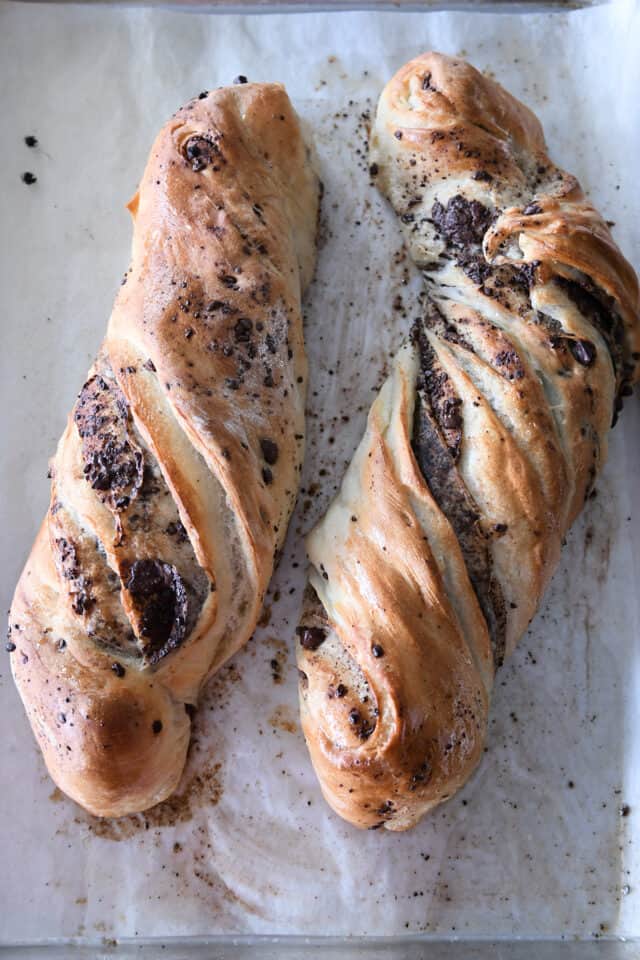
Amazing Chocolate Croissant French Bread
This bread is impossible to resist right out of the oven. It is so buttery and flaky – the crust literally crackles as you tear into it.
And speaking of tearing, you can go the rustic route and tear off pieces of bread to enjoy, or you can cut cleaner slices.
Either way, you’re going to experience crackly crust, buttery layers, fluffy bread, and rich, dark chocolate throughout.
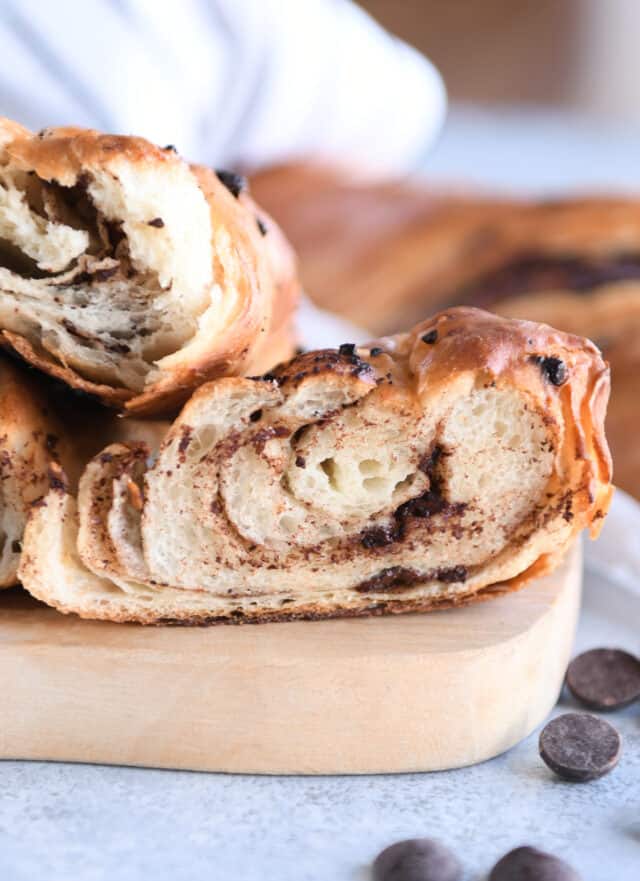
The Chocolate Croissant Debate
I know that for true croissant purists, this easy twisted chocolate croissant French bread can’t take the place of a beloved and authentic pain au chocolat.
But for those of us who want all the deliciousness of a chocolate croissant in a fraction of the time (and with way less work and waiting periods), this simpler chocolate croissant bread is a beautiful answer.
Not to mention that it is an absolute showstopper. A bread recipe to ensure instant rock star status and make you feel a million bucks of confidence in the kitchen. You can do it!
If the whole process seems intimidating, check out the videos I posted on Instagram that show the whole process step-by-step:
I am already dreaming up the next variation (cinnamon and sugar, I’m coming for you!).
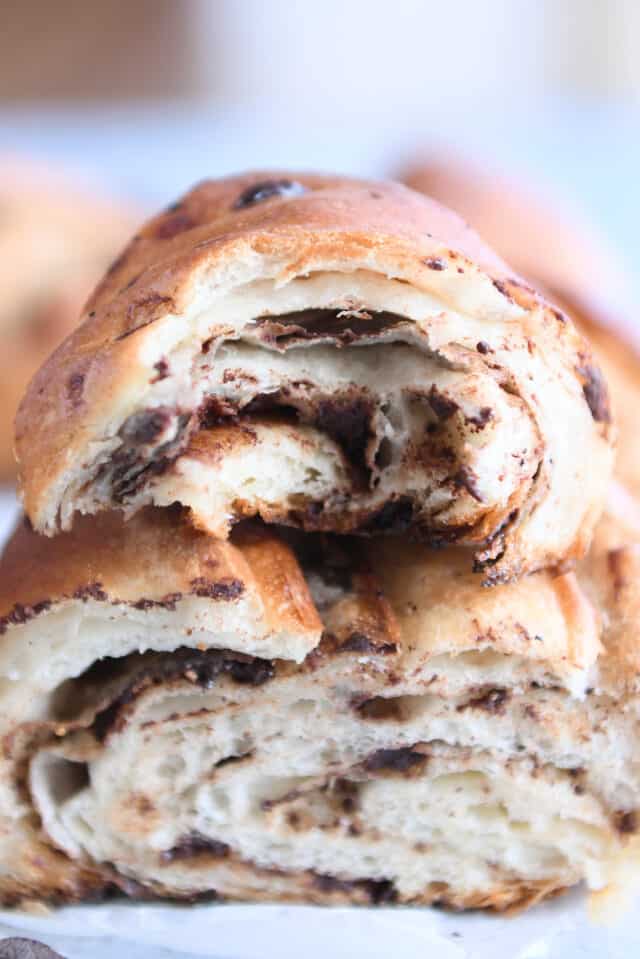
One Year Ago: Instant Pot Creamy Tomato Basil Soup
Two Years Ago: Easy Chicken Enchilada Casserole
Three Years Ago: Snickerdoodle Brookie Bars
Four Years Ago: Little Toasted Coconut Lime Bars
Five Years Ago: Carrot Cake Cookies with Cream Cheese Frosting
Six Years Ago: Delicious Whole Grain Hulk Muffins {Naturally Green!}
Seven Years Ago: Chicken Shepherd’s Pie with Garlic-Kale Mash
Eight Years Ago: No-Bake Thin Mint Cheesecakes
Nine Years Ago: Whipped Chocolate Buttercream Frosting
Ten Years Ago: Slow Cooker Tomato Basil Soup
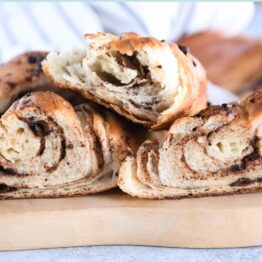
Easy Twisted Chocolate Croissant French Bread
Ingredients
- 1 cup (227 g) salted butter, cool room temperature
- 2 cups warm water, 105-110 degrees F
- 1 tablespoon instant or active dry yeast
- 2 tablespoons granulated sugar
- 1 1/2 teaspoons salt
- 4 3/4 (675 g) cups all-purpose flour, more or less (see note)
- ¾ to 1 cup (113 to 170 g) coarsely chopped good-quality semisweet or dark chocolate (see note)
Instructions
- For the butter packet: grab a piece of parchment paper about 16 1/4-inches by 12-inches (doesn't have to be exact, but should be close to those dimensions). Fold the two short edges of the parchment in toward each other about 4 1/2 inches. They will overlap a bit. Crease the edges well.
- Keep those edges folded in and fold the top and bottom edges in about 1 3/4-inches. It should form a little parchment packet when folded with the center rectangle dimensions about 8 1/2-inches by 7-inches. See pictures in the post for a visual.
- Unfold the parchment. Cut the butter into large pieces and place in the center of the parchment. Fold up the packet using the pre-creased folds and flip over so the folded edges are on the bottom.
- Use a rolling pin, lightly tap the butter (too much aggression here and the parchment could rip) until it starts to flatten and merge into a thick square. Continue tapping or use the rolling pin to roll the butter into a thin sheet so it reaches all the edges of the parchment packet and has a relatively even thickness. Place in the fridge to chill while you make the dough.
- For the dough: In the bowl of a stand mixer fitted with the dough hook, add the water, yeast and sugar, and let sit until foamy, 2-3 minutes. Add the salt and flour and mix until a soft dough forms that clears the sides of the bowl. Add more flour, a little at a time, if the dough is sticking to the dough hook or sides of the bowl.
- {It's REALLY important that this dough is not over floured and stiff or it will be hard to roll it out. On the flip side, a dough that is too soft and sticky can be problematic, too. Try for a dough that is soft and slightly sticky but easily clears the sides of the bowl. It should leave a light residue on your fingers but not be overly wet and sticky.}
- Knead for 3-4 minutes until the dough is soft and smooth.
- Cover the bowl or transfer the dough to a lightly greased bowl and cover. Let rise until doubled, about an hour.
- Lightly punch out the dough and turn out onto a lightly floured counter. Roll into a rectangle about 18-inches by 11- or 12-inches.
- Take the butter packet out of the refrigerator, and unfold the parchment (but leave the butter on the parchment paper). Place the butter packet face down on the center of the rolled out bread dough. Peel the parchment carefully off the butter leaving the butter sheet on the dough.
- Work quickly and don't over work the dough during the next couple steps of folding and rolling so the butter doesn't get too soft!
- Fold one short side of dough about halfway to 2/3 over the butter. Fold the other short side of dough over the butter, overlapping the first folded side by about an inch.
- Fold the top and bottom edges over about 1/2- to 1-inch and press to seal.
- Fold the dough in half (from right to left or vice versa) once more.
- Starting in the center, roll the dough out into a long, thin rectangle, about 8-inches by 22-inches. If the dough springs back when rolling, let it rest for 5-10 minutes to let the gluten relax and roll again.
- Sprinkle about 2/3 of the chocolate over the dough all the way to the edges. Press chocolate lightly into the dough.
- Fold one short edge of the long rectangle into the center over the chocolate. Repeat with the other short edge so they meet in the middle. Sprinkle remaining chocolate on bottom half of the dough, pressing the chocolate lightly into the dough.
- Fold the dough in half over the chocolate (from one of the short sides).
- Let the dough rest for 2-3 minutes. Prepare two half sheet pans by lining with parchment paper. Preheat the oven to 375 degrees F (400 degrees F for a darker crust).
- Roll into a 12-inch or 13-inch square. If the dough springs back when rolling, let it rest for 5-10 minutes to let the gluten relax and roll again. Cut the square into four strips.
- Take each strip, twist it 3-4 times and place on the prepared sheet pans (two strips per sheet pan, spaced several inches apart).
- Cover and let rise until noticeably puffy (the dough can rise in the refrigerator overnight or for several hours – when taking out of the refrigerator, if it hasn't risen enough, let it come to room temp and continue rising until nearly doubled). You don't want to let these loaves rise in an overly warm spot or the butter will melt before it hits the oven and you won't get the flaky, buttery layers.
- Bake the loaves until nicely golden, 20-22 minutes.
- Immediately out of the oven, use a pastry brush to brush any leaked butter on the sheet pan over the top of the loaves.
- Serve warm or at room temperature. Bread can be sliced or torn into pieces.
Notes
Recommended Products
Recipe Source: adapted from this twisted croissant French bread

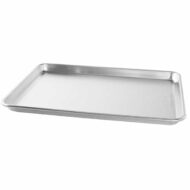
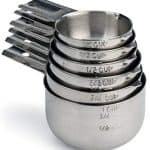
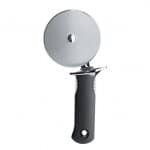
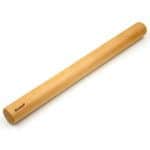
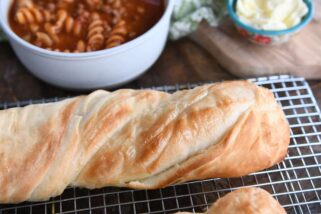
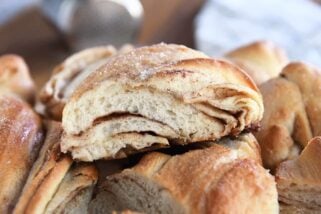
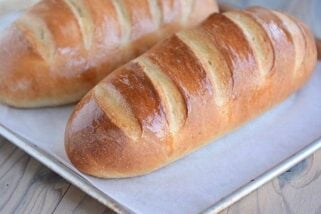

Seems more like a Pain Viennoise
Okayyyyyyyyy this is incredible. And totally doable! It’s the bread of dreams. The first loaf lasted 10 minutes and the second loaf didn’t last 24 hours. Amaaaaaaaaazing. And so easy! I could shout it from the rooftops 😂
Haha, so happy I’m not the only one that wants to shout from the rooftops about this one. So happy you loved it – thanks for taking the time to let me know!
Do you think it matters what kind of butter you use?
I use salted butter from Costco – different brands of butter may alter the end result slightly, but it shouldn’t be a big factor.
I made these this week and was pleasantly surprised how easy and fun the steps were. I’ve tried making croissants before and failed miserably, but this recipe was simple and delivered all the beautiful and buttery chocolate croissant goodness you’d hope for! My family loved it!
I LOVE this recipe and have made it several times! What I noticed, however, is that the crust is always really hard and tough – difficult to even chew through. But then when I made it in a different oven and elevation, it turned out beautifully, with no chewiness. Any ideas?? My friend also encountered the tough chewiness. We’re both at about sea level- could that affect things?
Interesting, Bonnie! When you made it (when it had no chewiness) what elevation were you at? Sounds like the elevation may make a difference. I have heard that at sea level, it might help to decrease the oven temperature by 25 degrees and/or add a bit less flour to the dough? Might be worth a try!
Ok this is helpful! When I made it perfectly, we were in St. George, looks like 2700’. ♀️ I don’t know enough to tell if that would matter but I’ll definitely try lowering my oven next go around. I think it’s time to try the cinnamon sugar variety!
Can I use unsalted butter instead? I don’t have salted and I wanted to try this recipe today
Yes, I think you probably can use unsalted butter – because I like the slightly salty taste of salted butter, I’d sprinkle a bit of salt across the butter when rolling out the butter packet.
I made this with Gygi’s mini cinnamon chips, since they’re mini I didn’t have to chop them, it was amazing! Tasted a lot like cinnamon rolls! Our family loves just the plain version of this bread as well, so yummy!!
I absolutely love the original recipe! AMAZING. Do you think this could be made with a cinnamon filling? I’m wondering how to do it since it already has so much butter. Any recommendations? I’m imagining a pretty amazing breakfast bread 🙂
Hi Erin, I haven’t tried it, but if it were me, I’d sprinkle a healthy amount of cinnamon and sugar inbetween each fold, maybe?
This is truly amazing. Your recipes made me feel like a star!! I cannot believe I made this gorgeous bread. The happiness I feel when the bread came out of the oven is indescribable. So crispy outside and so soft and fluffy inside. I added half the amount of chocolate chips to half the batch, so I had 2 loaves of plain bread and 2 loaves of chocolate bread. Both are wonderful. I had a challenging time folding the dough because I live in a hot and humid tropical country and the butter melts within a minute! I also leave the loaves in the fridge to rise, and put them directly in the oven to bake. But still the end result is wonderful. Next time, I will freeze the butter sheet which is a trick I used to make scones. It will slow down the melting. Thank you so much Mel for the amazing recipe. There are not enough stars I can give to this recipe. I’m going to try a cinnamon sugar version
Could sourdough be added to this croissant recipe?
It very likely could, but I haven’t tried it so I don’t have a good recommendation. Good luck if you try it!
I made this over the weekend. My technique and form definitely need some practice. Despite being less than attractive, they were delicious! I used chocolate in half, and King Arthur’s Cinnamon Sweet Bits in the other half. Highly recommend the cinnamon! I weighed the flour, but left about 1/4 cup out. It was still a little stiff. Next time I’ll short it a little more. Thanks, Mel!
Does the brand of butter make a difference in taste?
I use Kirkland brand butter (from Costco) and the results are stellar…I’m guessing brand can/will make a difference, but I haven’t tried it with other brands (or with European butter) as a comparison.
Have you tried freezing the baked loaves
I haven’t because we eat them so fast, but they should freeze just fine!
Did you try this with the Costco brand in the white bag?
I’m just wondering because they have two options and one is more expensive/better quality and might be ok in this.
I didn’t, sorry!
This recipe is so fun. I could make butter packets everyday. So satisfying I’m thinking there needs to be a cream cheese version. I’m thinking cheese danish bread….
I made double and gave away loaves to my neighbors. If they didn’t love us as neighbors before, we have definitely won them over. This bread is so good! Thanks for sharing the recipe.
These were incredible! I thought we would be able to share a loaf or two… but my family and I ate them all up real quick! So good. I did make the recipe and made 2 just plain than the other half just put chocolate on top of the last two and twisted them. Again so delicious, Thank you!
The first version of this was amazing! Can I make two original and two with chocolate? Then dinner and dessert are covered!
Yes, I bet you definitely could if you split the dough in half after the first folding and rolling (and then only add chocolate to one half)
I was a little apprehensive to start this recipe – but my oh my – I am sooooo glad I got over my fear. It’s so yummy! And was absolutely EASY (and forgiving)! I can’t wait for the cinnamon sugar version. THANK YOU Mel!
This looks amazing! After you do a cinnamon sugar version, could you figure out how to make a french chocolate twist (essentially this, but with pastry cream/custard spread, topped with chocolate chips/chunks, and then twisted). A bakery near me makes them, but they’re so expensive! Would love a recipe to make at home and this looks so close!
This was delicious! I used a mix of Ghirardelli 60% chocolate chips and Callebaut dark callets. It’s so nice to be able to make a chocolate croissant style recipe on a weeknight instead of over the course of a few days! It made for a good Monday night for sure! Just make sure to use a baking sheet with a rim! I wasn’t thinking and didn’t at first and butter leaked onto the bottom of my oven and smoked up my kitchen. Thankfully the bread was unaffected lol
So good, everyone must make this! My family loved it.
So happy you liked it!
I didn’t think it could get better than the plain croissant French bread but here we are! So delicious, Mel! I made the plain bread twice last week and the chocolate one this afternoon—it was unreal! I used Guittard super cookie chips (I think you would be a fan of these) and it was just so good. I’m on the edge of my seat waiting for the cinnamon version.
Thanks for letting me know, Megan! I *think* I’ve tried those super cookie chips before but it’s been a while. I’ll pick some up next time at the store!
Can you let it rise the second time in the refrigerator over night?
Yep!
This looks yummy! I got into Babka breads a few years ago and they are so fun! I make an Italian one that my kids beg for. If you look on the internet, the chocolate ones are popular. They sky’s the limit though…white chocolate cherry, cinnamon roll, etc. What I love the most is how pretty they are!
Keep posting! We LOVE Mel’s Kitchen Cafe!!
Thank you, Emily!
I’m so glad you mentioned the cinnamon sugar variety at the end of the post. I will be anxiously waiting but in the meanwhile we try out this chocolate version. The regular plain croissant bread received rave reviews!
Yes!! I’m the chocolate croissant favorite food girl from the original croissant bread post. This just made my Monday! Can’t wait to try it!